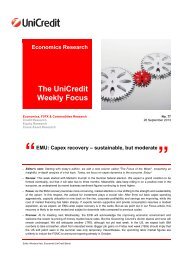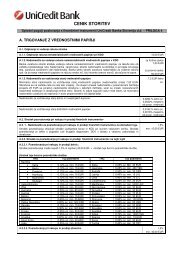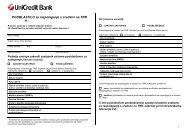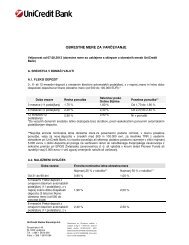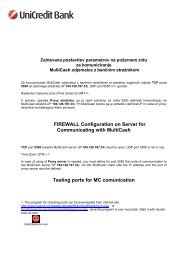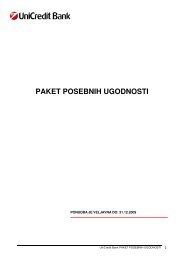Letno poroÄilo 2009.pdf - UniCredit Banka Slovenija dd
Letno poroÄilo 2009.pdf - UniCredit Banka Slovenija dd
Letno poroÄilo 2009.pdf - UniCredit Banka Slovenija dd
- No tags were found...
You also want an ePaper? Increase the reach of your titles
YUMPU automatically turns print PDFs into web optimized ePapers that Google loves.
Risk ReportRisk ReportOverall Risk ManagementIn line with the <strong>UniCredit</strong> Group perspective, <strong>UniCredit</strong> <strong>Banka</strong> <strong>Slovenija</strong> d.d. identifies, measures, monitors, and/or manages the followingcategories of risk:• Credit risk;• Market risk (foreign exchange, interest rate, equity trading and commodity risk);• Liquidity risk;• Operational risk;• Business risk;• Real estate risk;• Risks arising from the Bank's shareholdings and equity interests.The Bank manages its risks as well as its capital in a coordinated manner at all relevant levels within its organization. Furthermore, the riskmanagement framework is part of the <strong>UniCredit</strong> Group's CEE risk management practice and of course supports the <strong>UniCredit</strong> Group’s efforts toestablish uniform Group-wide risk management and control procedures.All risk management activities of <strong>UniCredit</strong> <strong>Banka</strong> <strong>Slovenija</strong> d.d. are conducted by the Risk Management division, which is independent fromthe business units and reports to the Management Board and to the CEO (Chairman of the Management Board). There are three types ofcommittees on the high level, which are central to the risk function: the Assets and Liabilities Committee (ALCO), the Credit Committee andthe Operational Risk Committee.Asset/Liability Committee (ALCO)The ALCO, as the overall risk management committee for <strong>UniCredit</strong> <strong>Banka</strong> <strong>Slovenija</strong> d.d., determines the risk management principles in theoverall bank risk policy and validates on a regular basis the Bank’s risk map. It approves the establishment of limits for all relevant risks andthe risk control procedures. ALCO is responsible for the management of the balance-sheet structural positions, controls liquidity and interestrate risk, is informed about loan portfolio and deals with cross-divisional risk management issues arising between sales units and the overallbank management. The ALCO also deals with all issues relating to overall bank risk and capital management. It has an overview of capitaladequacy, development of regulatory capital and ratios, economic capital, capital allocation and available financial resources.Credit committeEFor the approval of customer credit exposures, the Bank uses a two-level credit committee structure, whereas the (potential) exposure amountof the client or the group of clients determines which level of credit committee is responsible for taking the approval decision. In both creditcommittees, representatives of the Risk Management and Sales divisions are present. Credit committee sessions are held two times per week.Procedures are prescribed and written down in guidelines. Lower exposures and exposures toward private individual clients are organized inthe Bank via individual approval rights delegated by the highest level Credit Committee of the Bank.Operational Risk Committee (OpRisk Committee)The OpRisk Committee is responsible for effective oversight over operational risk exposure. The OpRisk Committee shall have an overallunderstanding of the operational risk control framework and of how operational risk affects the company. The OpRisk Committee is alsoresponsible for verifying that the operational risk measurement and control system is closely integrated in the day-to-day risk managementprocess of the Bank. The OpRisk Committee meets on bimonthly basis.Risk takingIn the state-of-the-art banking business set-up, client business has to be treated free of interest rate, foreign exchange, and liquidity risk. As aconsequence, it is necessary to determine a clear pricing basis for customer loans and deposits, in order to enable a clear separation of clientbusiness benefit from the internal funds management function of the Bank. The market and liquidity risks are transferred via a market-basedfund transfer pricing system to the risk taking units. This makes it possible to attribute market and liquidity risk and contribution margins to theBank's business divisions in line with the principle of causation.Within the Bank, the Markets division is the only unit that has the responsibility to manage market risks. The liquidity risk is managed by theALM department which reports directly to the CFO. The Markets division and ALM are accountable for optimizing the Bank’s overall maturitystructure and the return on it.206 2009 Annual Report · <strong>UniCredit</strong> Bank



